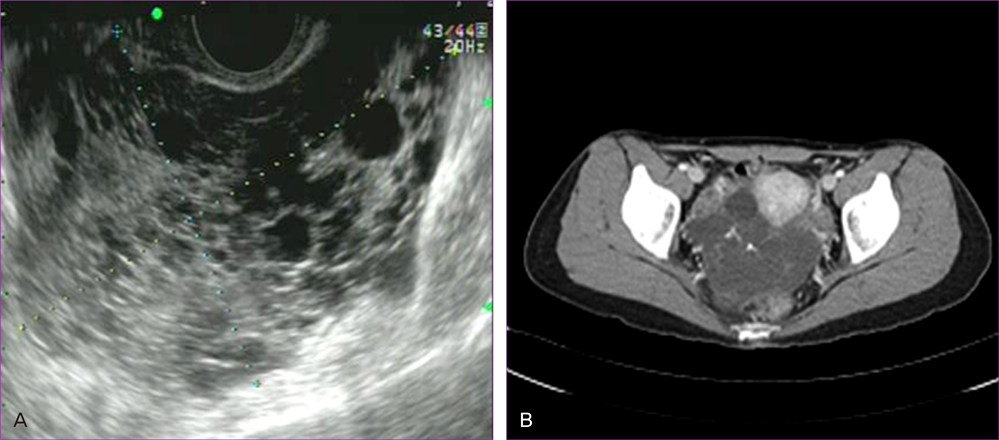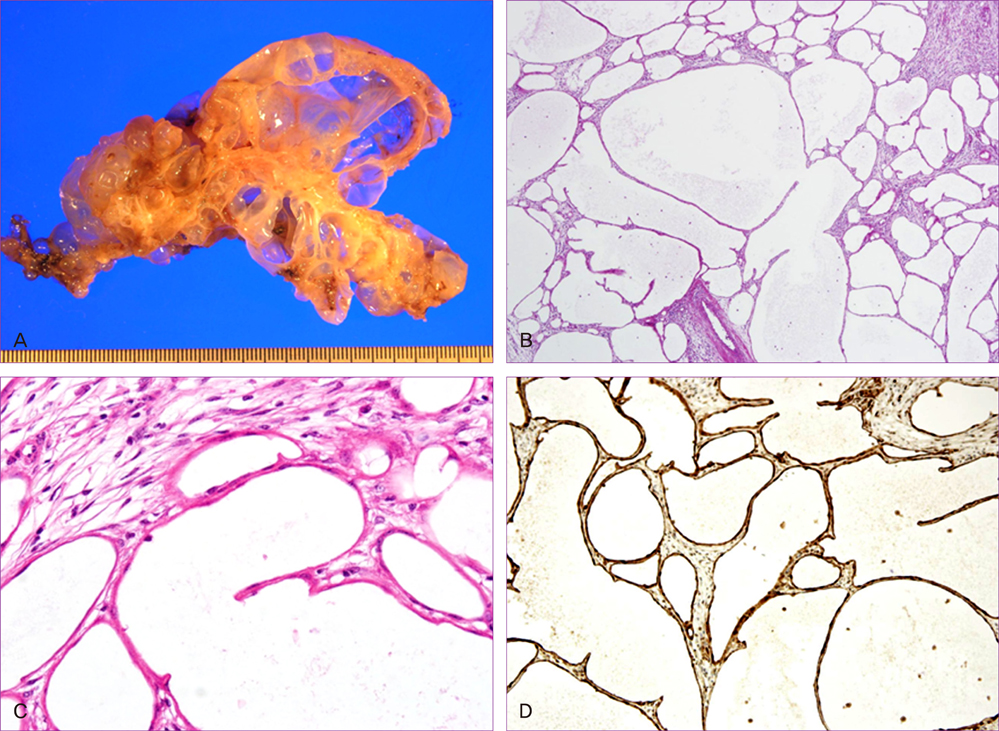Obstet Gynecol Sci.
2013 Mar;56(2):126-129. 10.5468/OGS.2013.56.2.126.
Multicystic benign mesothelioma of the pelvic peritoneum presenting as acute abdominal pain in a young woman
- Affiliations
-
- 1Department of Obstetrics and Gynecology, Soonchunhyang University Cheonan Hospital, Cheonan, Korea. sjeon@schmc.ac.kr
- 2Department of Pathology, Soonchunhyang University Cheonan Hospital, Cheonan, Korea.
- 3Department of Obstetrics and Gynecology, Soonchunhyang University Bucheon Hospital, Soonchunhyang University College of Medicine, Bucheon, Korea.
- KMID: 1425660
- DOI: http://doi.org/10.5468/OGS.2013.56.2.126
Abstract
- Multicystic benign mesothelioma (MBM) of the peritoneum is a very rare condition. Since the first description of MBM in 1979, approximately 100 cases have been reported. This is a case report of MBM of the pelvic peritoneum presenting as acute abdominal pain in a young woman. Laparoscopy confirmed multiple grapelike clusters of cysts that originated in the peritoneum of the rectouterine pouch and histopathologic diagnosis was confirmed as MBM of the pelvic peritoneum. We hope to alert gynaecologists of the diagnostic and therapeutic approaches to MBM which can be accomplished by laparoscopy.
Keyword
Figure
Cited by 1 articles
-
Benign multicystic peritoneal mesothelioma treated with laparoendoscopic single site surgery: a case report and review of the literature
Kyung Sun Cha, Yong Hee Choi, Yong Seok Lee, Eun Kyung Park
Obstet Gynecol Sci. 2018;61(1):170-174. doi: 10.5468/ogs.2018.61.1.170.
Reference
-
1. van Ruth S, Bronkhorst MW, van Coevorden F, Zoetmulder FA. Peritoneal benign cystic mesothelioma: a case report and review of the literature. Eur J Surg Oncol. 2002. 28:192–195.2. Weiss SW, Tavassoli FA. Multicystic mesothelioma. An analysis of pathologic findings and biologic behavior in 37 cases. Am J Surg Pathol. 1988. 12:737–746.3. Sawh RN, Malpica A, Deavers MT, Liu J, Silva EG. Benign cystic mesothelioma of the peritoneum: a clinicopathologic study of 17 cases and immunohistochemical analysis of estrogen and progesterone receptor status. Hum Pathol. 2003. 34:369–374.4. Miles JM, Hart WR, McMahon JT. Cystic mesothelioma of the peritoneum. Report of a case with multiple recurrences and review of the literature. Cleve Clin Q. 1986. 53:109–114.5. Raafat F, Egan M. Benign cystic mesothelioma of the peritoneum: immunohistochemical and ultrastructural features in a child. Pediatr Pathol. 1988. 8:321–329.6. Carpenter HA, Lancaster JR, Lee RA. Multilocular cysts of the peritoneum. Mayo Clin Proc. 1982. 57:634–638.7. Safioleas MC, Constantinos K, Michael S, Konstantinos G, Constantinos S, Alkiviadis K. Benign multicystic peritoneal mesothelioma: a case report and review of the literature. World J Gastroenterol. 2006. 12:5739–5742.8. Assaly M, Bongiovanni M, Kumar N, Egger JF, Pelte MF, Genevay M, et al. Cytology of benign multicystic peritoneal mesothelioma in peritoneal washings. Cytopathology. 2008. 19:224–228.9. Letterie GS, Yon JL. The antiestrogen tamoxifen in the treatment of recurrent benign cystic mesothelioma. Gynecol Oncol. 1998. 70:131–133.10. Benson RC Jr, Williams TH. Peritoneal cystic mesothelioma: successful treatment of a difficult disease. J Urol. 1990. 143:347–348.11. Gonzalez-Moreno S, Yan H, Alcorn KW, Sugarbaker PH. Malignant transformation of "benign" cystic mesothelioma of the peritoneum. J Surg Oncol. 2002. 79:243–251.
- Full Text Links
- Actions
-
Cited
- CITED
-
- Close
- Share
- Similar articles
-
- Multicystic mesothelioma of the peritoneum: case report
- Benign Multicystic Mesothelioma in the Left Round Ligament: Case Report
- Complicated benign cystic mesothelioma of mesoappendix misdiagnosed as an appendiceal abscess in a postpartum period woman
- Multicystic Mesothelioma of the peritoneum: A case Report
- Benign cystic mesothelioma of the peritoneum: a case report



